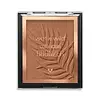What's inside
What's inside
 Key Ingredients
Key Ingredients

 Benefits
Benefits

 Concerns
Concerns

 Ingredients Side-by-side
Ingredients Side-by-side

Caprylic/Capric Triglyceride
MaskingSynthetic Fluorphlogopite
Boron Nitride
AbsorbentMicrocrystalline Cellulose
AbsorbentSilica
AbrasiveDimethicone
EmollientMagnesium Myristate
Dimethicone/Vinyl Dimethicone Crosspolymer
Skin ConditioningPhenoxyethanol
PreservativeLauroyl Lysine
Skin ConditioningCaprylyl Glycol
EmollientEthylhexylglycerin
Skin ConditioningHexylene Glycol
EmulsifyingTin Oxide
AbrasiveWater
Skin ConditioningO-Cymen-5-Ol
AntimicrobialTriethoxycaprylylsilane
Iron Oxides
CI 77492
Cosmetic ColorantCI 77499
Cosmetic ColorantMica
Cosmetic ColorantTitanium Dioxide
Cosmetic ColorantCaprylic/Capric Triglyceride, Synthetic Fluorphlogopite, Boron Nitride, Microcrystalline Cellulose, Silica, Dimethicone, Magnesium Myristate, Dimethicone/Vinyl Dimethicone Crosspolymer, Phenoxyethanol, Lauroyl Lysine, Caprylyl Glycol, Ethylhexylglycerin, Hexylene Glycol, Tin Oxide, Water, O-Cymen-5-Ol, Triethoxycaprylylsilane, Iron Oxides, CI 77492, CI 77499, Mica, Titanium Dioxide
C12-15 Alkyl Ethylhexanoate
EmollientZinc Stearate
Cosmetic ColorantMethyl Methacrylate/Glycol Dimethacrylate Crosspolymer
Alumina
AbrasiveLauroyl Lysine
Skin ConditioningPentaerythrityl Tetraethylhexanoate
EmollientCaprylyl Glycol
EmollientWater
Skin ConditioningBisabolol
MaskingPanthenyl Triacetate
Hexylene Glycol
EmulsifyingTriethoxycaprylylsilane
Silica
AbrasiveBHT
AntioxidantPotassium Sorbate
PreservativePhenoxyethanol
PreservativeFarnesyl Acetate
PerfumingFarnesol
PerfumingMica
Cosmetic ColorantCI 77891
Cosmetic ColorantCI 77491
Cosmetic ColorantCI 77492
Cosmetic ColorantCI 77499
Cosmetic ColorantCI 77007
Cosmetic ColorantCI 75470
Cosmetic ColorantCI 19140
Cosmetic ColorantC12-15 Alkyl Ethylhexanoate, Zinc Stearate, Methyl Methacrylate/Glycol Dimethacrylate Crosspolymer, Alumina, Lauroyl Lysine, Pentaerythrityl Tetraethylhexanoate, Caprylyl Glycol, Water, Bisabolol, Panthenyl Triacetate, Hexylene Glycol, Triethoxycaprylylsilane, Silica, BHT, Potassium Sorbate, Phenoxyethanol, Farnesyl Acetate, Farnesol, Mica, CI 77891, CI 77491, CI 77492, CI 77499, CI 77007, CI 75470, CI 19140
 Reviews
Reviews

Ingredients Explained
These ingredients are found in both products.
Ingredients higher up in an ingredient list are typically present in a larger amount.
Caprylyl Glycol is a humectant and emollient, meaning it attracts and preserves moisture.
It is a common ingredient in many products, especially those designed to hydrate skin. The primary benefits are retaining moisture, skin softening, and promoting a healthy skin barrier.
Though Caprylyl Glycol is an alcohol derived from fatty acids, it is not the kind that can dry out skin.
This ingredient is also used as a preservative to extend the life of products. It has slight antimicrobial properties.
Learn more about Caprylyl GlycolCi 77492 is also hydrated iron III oxide. It's sole purpose is to give a yellow hue to products.
Iron III oxides are classified as inorganic chemicals for coloring.
Synthetically created Ci 77492 is considered safer than those naturally found. This is because the synthetically created version may contain less impurities. Iron oxides are generally non-toxic and non-allergenic.
Learn more about CI 77492Ci 77499 is also hydrated iron III oxide. It is created from mixing red and black iron oxides. This helps give shades of darkness to a product.
Iron III oxides are classified as inorganic chemicals for coloring.
Hexylene Glycol is a surfactant. Glycols are a class of alcohols. Hexylene Glycol is a surfactant and emulsifier.
As a surfactant, Hexylene Glycol helps gather dirt and oil on your skin to be washed away.
As an emulsifier, Hexylene Glycol helps keep water and oil together. This prevents them from separating in a product. Hexylene Glycol also thins out the texture of a product by lessening viscosity.
Hexylene Glycol has a small molecular weight.
Learn more about Hexylene GlycolThis ingredient comes from a fatty acid (lauric acid) and amino acid (lysine). It is used to add a silky feel to cosmetics.
According to a manufacturer, its fatty acid base leaves a silky feeling on the skin. It also has emollient properties because of this. Emollients help soften skin by preventing water from evaporating.
Lauroyl lysine is barely soluble in water.
Learn more about Lauroyl LysineMica is a naturally occurring mineral used to add shimmer and color in cosmetics. It can also help improve the texture of a product or give it an opaque, white/silver color.
Serecite is the name for very fine but ragged grains of mica.
This ingredient is often coated with metal oxides like titanium dioxide. Trace amounts of heavy metals may be found in mica, but these metals are not harmful in our personal products.
Mica has been used since prehistoric times throughout the world. Ancient Egyptian, Indian, Greek, Roman, Aztec, and Chinese civilizations have used mica.
Learn more about MicaPhenoxyethanol is a preservative that has germicide, antimicrobial, and aromatic properties. Studies show that phenoxyethanol can prevent microbial growth. By itself, it has a scent that is similar to that of a rose.
It's often used in formulations along with Caprylyl Glycol to preserve the shelf life of products.
Silica, also known as silicon dioxide, is a naturally occurring mineral. It is used as a fine, spherical, and porous powder in cosmetics.
Though it has exfoliant properties, the function of silica varies depending on the product.
The unique structure of silica enhances the spreadability and adds smoothness, making it a great texture enhancer.
It is also used as an active carrier, emulsifier, and mattifier due to its ability to absorb excess oil.
In some products, tiny microneedles called spicules are made from silica or hydrolyzed sponge. When you rub them in, they lightly polish away dead skin layers and enhance the penetration of active ingredients.
Learn more about SilicaTriethoxycaprylylsilane is a silicone used to bind and stabilize ingredients.
As an emulsifier, it helps prevent ingredients from separating. This can help elongate the shelf life of products.
Triethoxycaprylylsilane is often used to coat mineral sunscreens ingredients to help give a better feel. It also helps reduce oxidative stress in sunscreens.
Learn more about TriethoxycaprylylsilaneWater. It's the most common cosmetic ingredient of all. You'll usually see it at the top of ingredient lists, meaning that it makes up the largest part of the product.
So why is it so popular? Water most often acts as a solvent - this means that it helps dissolve other ingredients into the formulation.
You'll also recognize water as that liquid we all need to stay alive. If you see this, drink a glass of water. Stay hydrated!
Learn more about Water